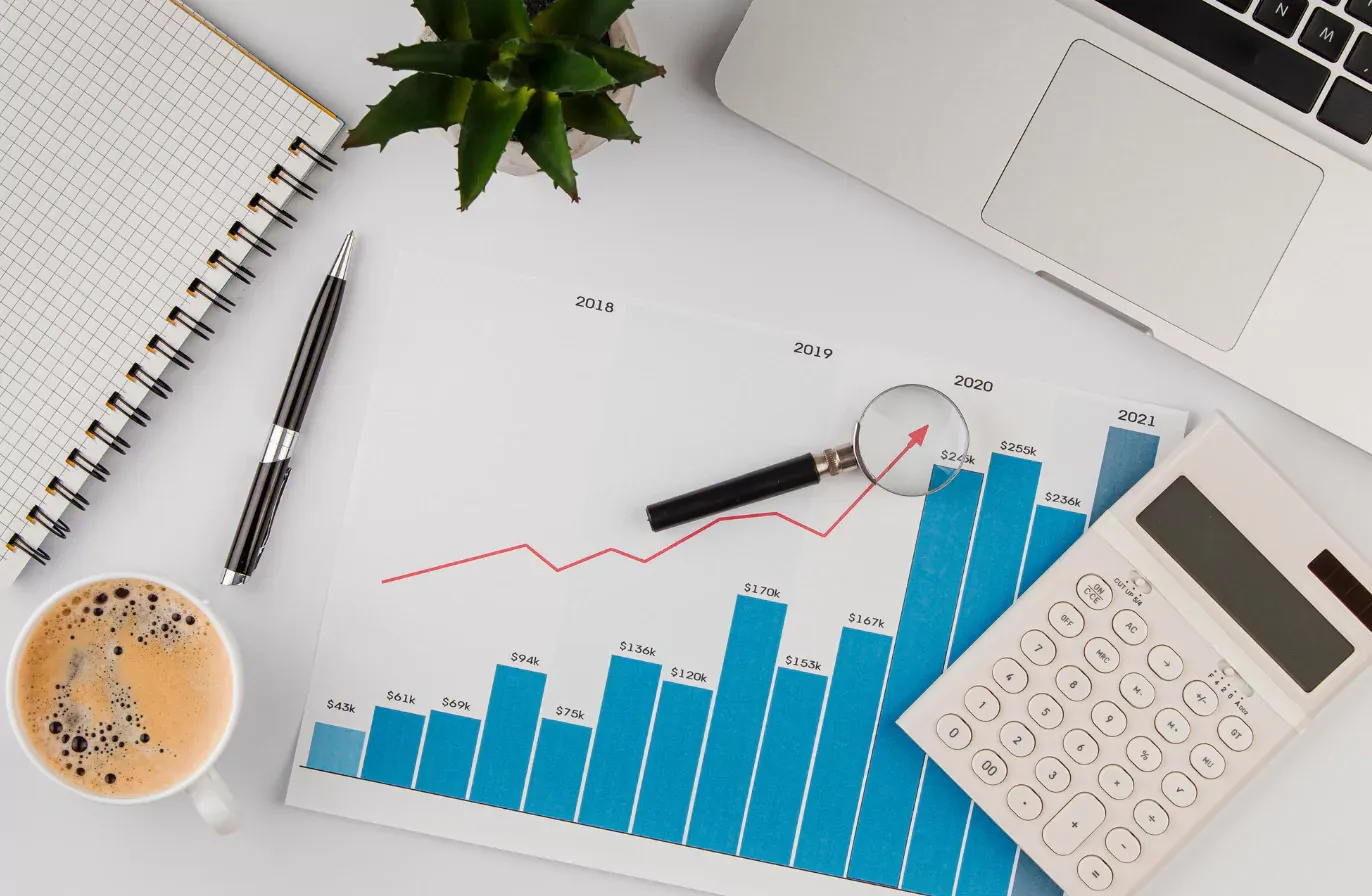The struggle is real for social media strategists juggling campaigns across platforms.
Analyzing results is crucial, but manually tracking data from each platform is time-consuming and inefficient. Enter the social media dashboard: the key to streamlining social media analytics.
Social media dashboards centralize data from all platforms, saving you the time and hassle of jumping between accounts. This translates to better efficiency and more accurate insights to fuel your social media strategies and decisions.
In this article, you'll discover social media dashboard examples an how to build your social media analytics dashboard.
Table of Contents
What is a social media dashboard?
Why do you need a dashboard for social media?
9 Social media dashboard templates
How to build your own social media dashboard
What is a social media dashboard?
A social media dashboard provides social media managers and businesses with a dynamic reporting tool, enabling them to conveniently access their social media data in a centralized hub.
Social media dashboards display metrics such as engagement rates, follower growth, and content performance across different channels, allowing brands to assess the success of their marketing strategies at a glance.
Social media reporting dashboards seamlessly retrieve and visually present real-time data, streamlining the monitoring process and empowering stakeholders to make informed decisions and react quickly.
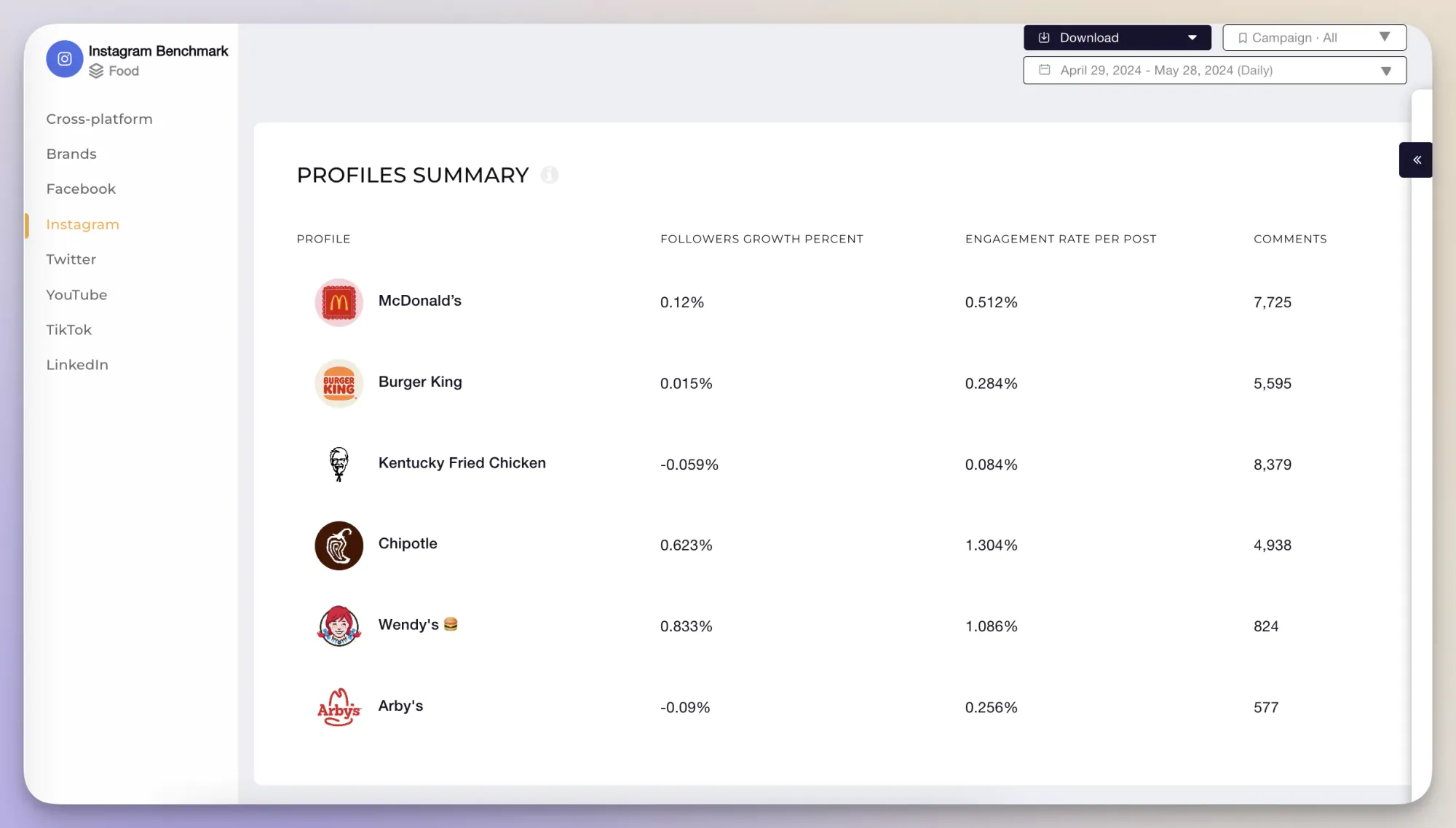
Reach new business horizons by integrating social media API data
You can access all the social media data you need through Socialinsider API integration.
Why do you need a dashboard for social media?
You can already access social media analytics within every platform, right? So why go to the trouble of creating a centralized social media dashboard?
That’s precisely it. With the right tools, creating social dashboards is the opposite of “trouble” and has many benefits:
Boost productivity
Instead of spreading your marketing team thin as they work on various platforms, a dashboard for social media monitoring can help everyone spend their time more wisely and creatively.
Stay up-to-date and competitive
A social media metrics dashboard makes tracking mentions, hashtags, influencer activity, and content themes less complicated.
Create more relevant and engaging content
Refine your content strategy on the go and create more powerful social media posts.
Make better decisions with relevant analytics
Marketing campaigns generate a lot of data, which can be difficult to analyze, but thanks to social media dashboard software, this task is automated and streamlined.
Reduce redundancy and simplify data management
Centralization allows companies to allocate resources more effectively and potentially increase their ROI, according to Improvado.
Want to get started?
Let’s look at these top social media dashboard templates and learn how to build them.
9 Social media dashboard templates
Depending on your business needs and marketing goals, different social dashboards will best serve your interests.
9 Social media dashboard examples:
- Brand awareness dashboard
- Social media engagement dashboard
- Social media audience growth dashboard
- Competitor analysis dashboard
- Social media benchmarks dashboard
- Social media conversion dashboard
- Network-specific dashboard
- Business intelligence dashboard
- Social media dashboard for executive teams
1. Brand awareness dashboard
Building brand awareness is the first step towards growing a following and a loyal customer base. This is why a brand awareness dashboard is a must for most businesses. It allows you to continuously monitor key metrics that reveal the impact of your efforts.
Key metrics
- Branded search volume. Track how often users search for your brand directly, indicating brand recall and potential customer intent.
- Share of impressions. Understand how often your brand appears compared to competitors within your target audience's view.
- Share of voice. Analyze the conversation surrounding your brand - how much is it about you compared to competitors?
- Social media engagement. Likes, comments, and shares reveal user interaction with your brand, reflecting brand recognition.
- Click-through rate (CTR). Measure how efficient your content is at driving action by seeing how many users click your links (organic or paid).
- Website traffic. Measure website visits and identify traffic sources to measure campaign effectiveness and find improvement opportunities.
Channels to include:
The specific channels you monitor in your awareness dashboard depend on your target audience and marketing goals.
Popular platforms to include:
- Facebook — offers a broad reach and allows for targeted advertising.
- Instagram — great for visual storytelling and engaging with a younger demographic.
- YouTube — increase brand visibility through video marketing.
- TikTok — rapidly growing, ideal for reaching a Gen Z audience.
Frequency
Since the digital environment offers many opportunities to refine brand awareness strategies, consider weekly or monthly monitoring. This allows you to identify trends and react quickly to optimize your campaigns.
2. Social media engagement dashboard
Engagement is essential for a successful social media presence as it reflects how your audience resonates with your content and brand. A dedicated social media engagement dashboard helps you track these interactions in one central location, making it easier to:
- Benchmark performance across channels. Generate a cross-channel analysis report to understand where your audience is most active.
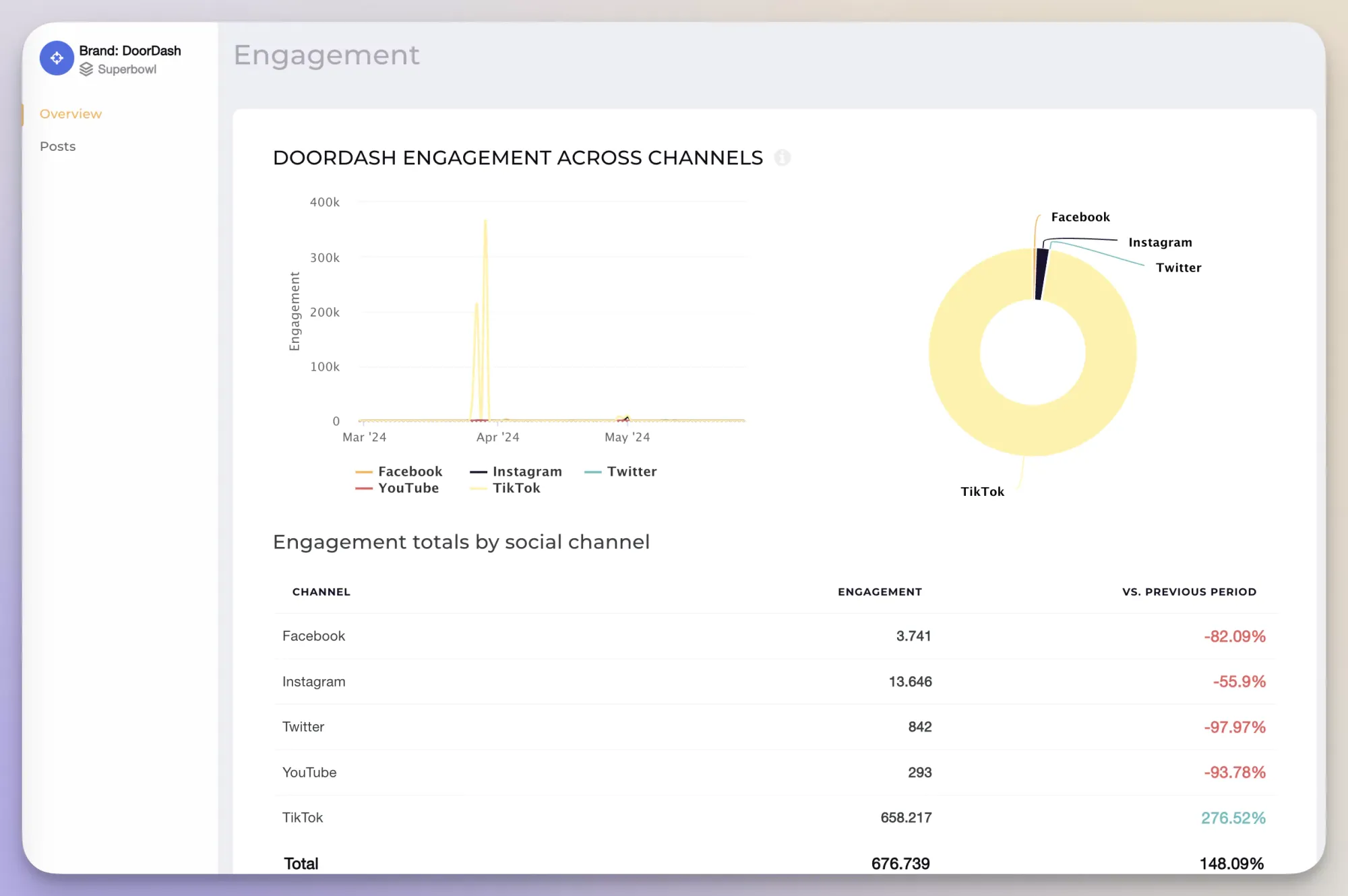
- Analyze individual profile performance. A profile performance report helps you track engagement trends for each of your social media profiles, revealing areas for improvement or highlighting successful strategies, and audit your social media.
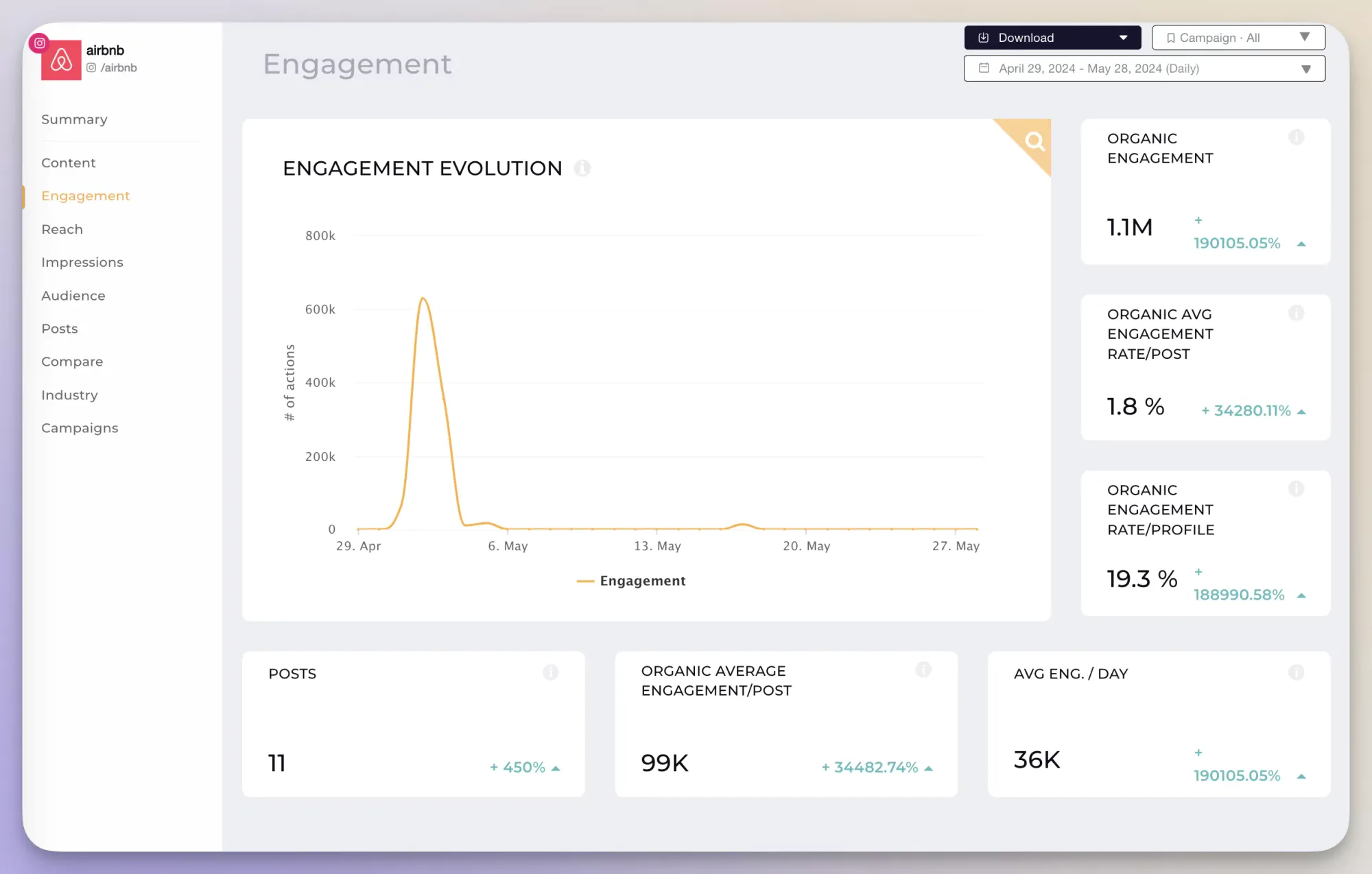
- Gain insights into specific types of engagement (likes, comments, shares, saves, or clicks) to best-performing social media content pillars and areas of improvement.
Key metrics
- Engagement evolution. Track overall engagement trends to identify highs, lows, and potential causes.
- Average engagement rate per post. Get a quick snapshot of your overall content strategy's performance in driving audience interaction.
- Post engagement by type. See what content resonates best with your audience by analyzing engagement breakdowns for individual posts.
- Average engagement per day. Identify and understand fluctuations in engagement levels.
- Engagement rate by impressions. Measure content effectiveness by analyzing how many viewers actually interact with your posts.
- Best time to post by engagement. Schedule posts strategically by revealing peak audience activity times.
Channels to include:
Your brand’s social media engagement dashboard should focus on the channels most relevant to your audience.
Use the data to refine your social media strategy and focus on the channels that drive the best performance.
- Facebook — track comments, shares, and overall conversation.
- Instagram — monitoring engagement with visual content.
- X (Twitter) — measure real-time conversation and social sentiment.
- YouTube — understand viewer engagement with your video content.
- TikTok — track video views, comments, shares, likes, and conversations.
Frequency
Engagement metrics on social media can fluctuate rapidly. To react to trends in real time and avoid damaging brand reputation, consider daily or weekly monitoring of your social media KPI dashboard, especially on more dynamic platforms like TikTok or X.
3. Social media audience growth dashboard
An audience growth dashboard dynamically tracks your follower growth rate, helping tailor your social media presence for building a bigger, more engaged community around your brand.
Key metrics
- Follower count. Track the total number of followers to measure brand popularity.
- Follower growth by channel. See the rate at which your follower count is evolving on different channels to understand whether your strategies are working or not.
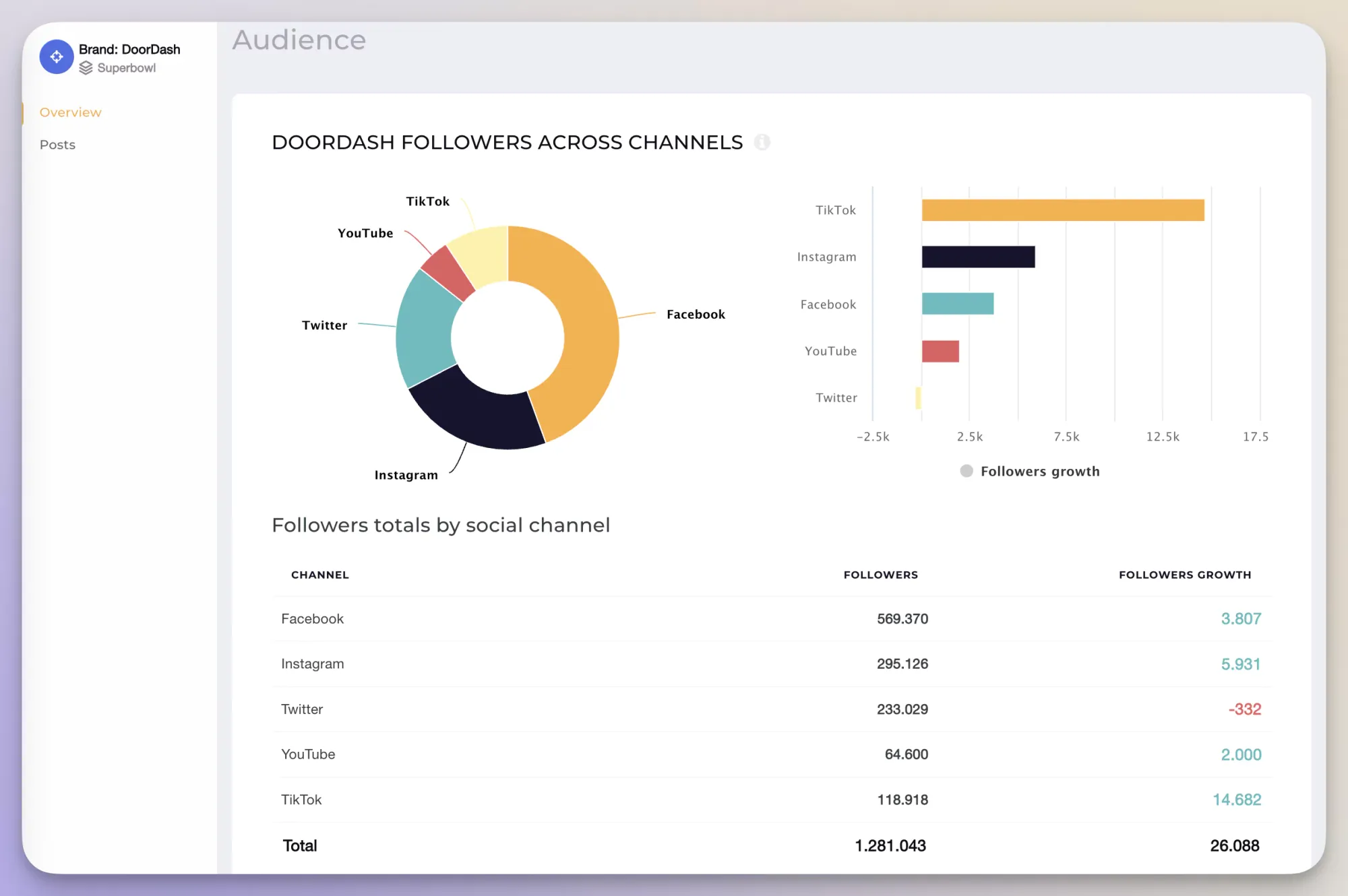
- Impressions. Measure the number of times your content is viewed.
- Reach. Analyze how many unique users see your posts.
- Follower demographics. Get insights into the age, gender, and location of your audience.
Channels to include:
- Facebook and Instagram — insights into follower trends and content interaction.
- TikTok — engagement trends and growth among younger audiences.
- Twitter — real-time feedback on brand sentiment and growth metrics.
- YouTube — essential, especially if your efforts are geared toward video marketing.
Frequency:
While follower is essential, focus on it as a medium and long term goal. Check the audience growth dashboard monthly to see if your overall efforts are translating into followers and notice any dip that can indicate a problem.
4. Competitor analysis dashboard
A competitor analysis dashboard is a strategic tool your marketing toolkit can't miss. By analyzing what your competitors are doing, you can identify successful strategies and avoid pitfalls. Including competitior analytics in your social media dashboard enables you to stay informed and agile.
Key metrics
- Performance comparison on KPIs (reach, impressions, engagement, etc.). Assess how your metrics stack up against your competitors to identify areas for improvement and growth opportunities.
- Content themes performance. Analyze your competitors' content pillars to identify content gaps and improve your strategies.
- Cross-channel analysis. Audit your competitor's channels and compare performance across channels.
- Brand mentions. Track how often your competitors are mentioned across social platforms.
- Followers. Measure the audience size and growth of your competitors.
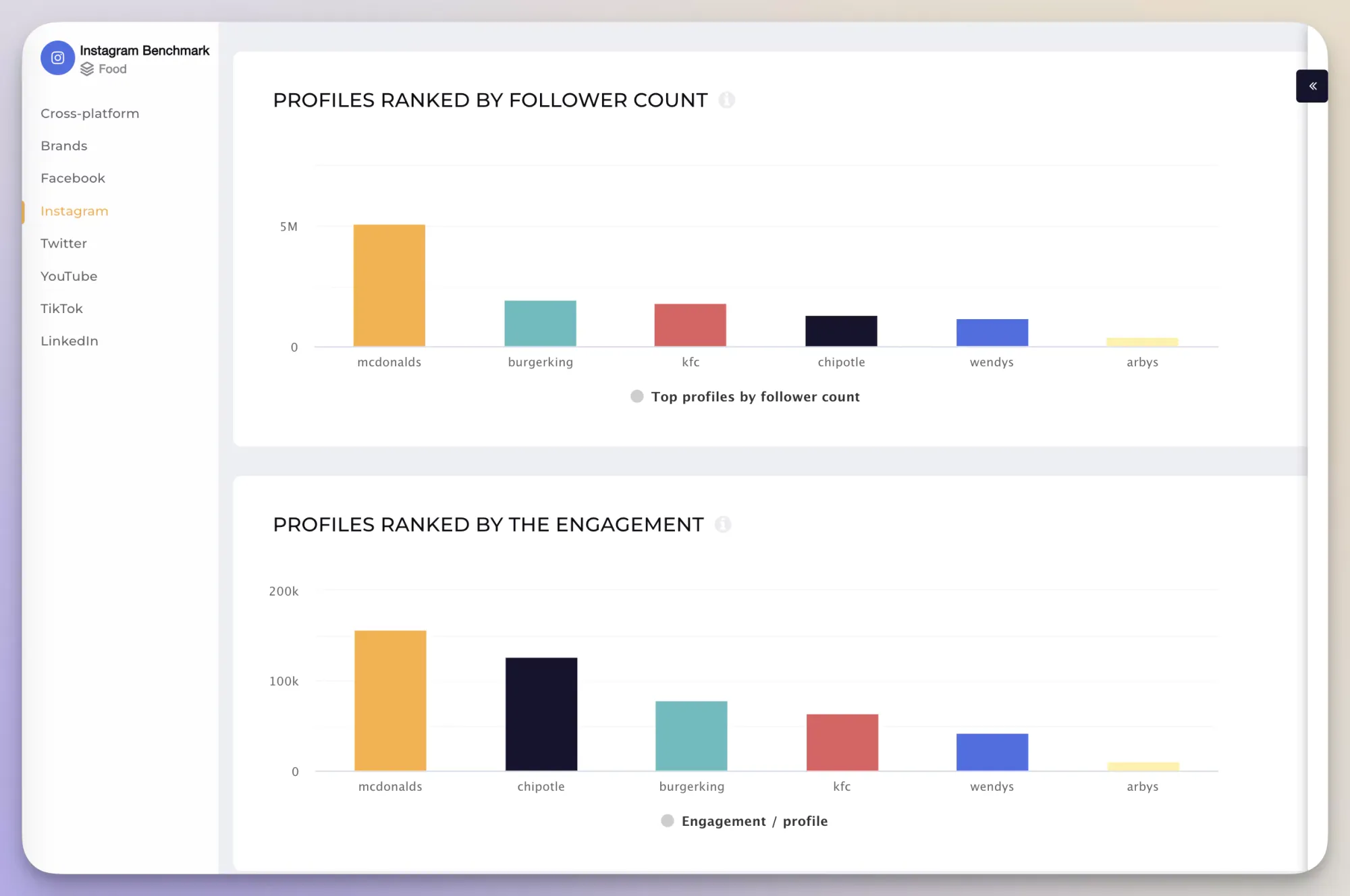
Channels to include:
- Facebook and Instagram — key for demographic insights, content comparison, hashtag analysis, influencer collaborations, and engagement analysis.
- Twitter — useful for real-time competitor updates.
- LinkedIn — important for B2B market comparisons and content strategies.
Frequency
Analyze your competitor analysis dashboard regularly, especially when you're reassessing your social media strategy and planning for improvements. Invest in a dashboard that gives your brand a competitive edge and positions you as the go-to person for insights into your company.
5. Social media benchmarks dashboard
Social media benchmarks dashboards provide a clear perspective on where you stand in in terms of digital performance. This social media dashboard enables you to monitor various brands across platforms, helping you strategize and make decisions based on actionable data.
Key metrics
- Engagement rate. Measures interactions (likes, comments, shares) relative to the follower count.
- Reach. Assess how many unique users see posts from your brand compared to competitors.
- Post type performance. Monitor the social media content to compare and adjust content strategies.
- Engagement per post. Evaluate the average interaction each post receives, providing insights into content type or topic effectiveness.
- Followers and follower evolution. Track the number of followers over time to see how other brands are doing in terms of popularity and growth.
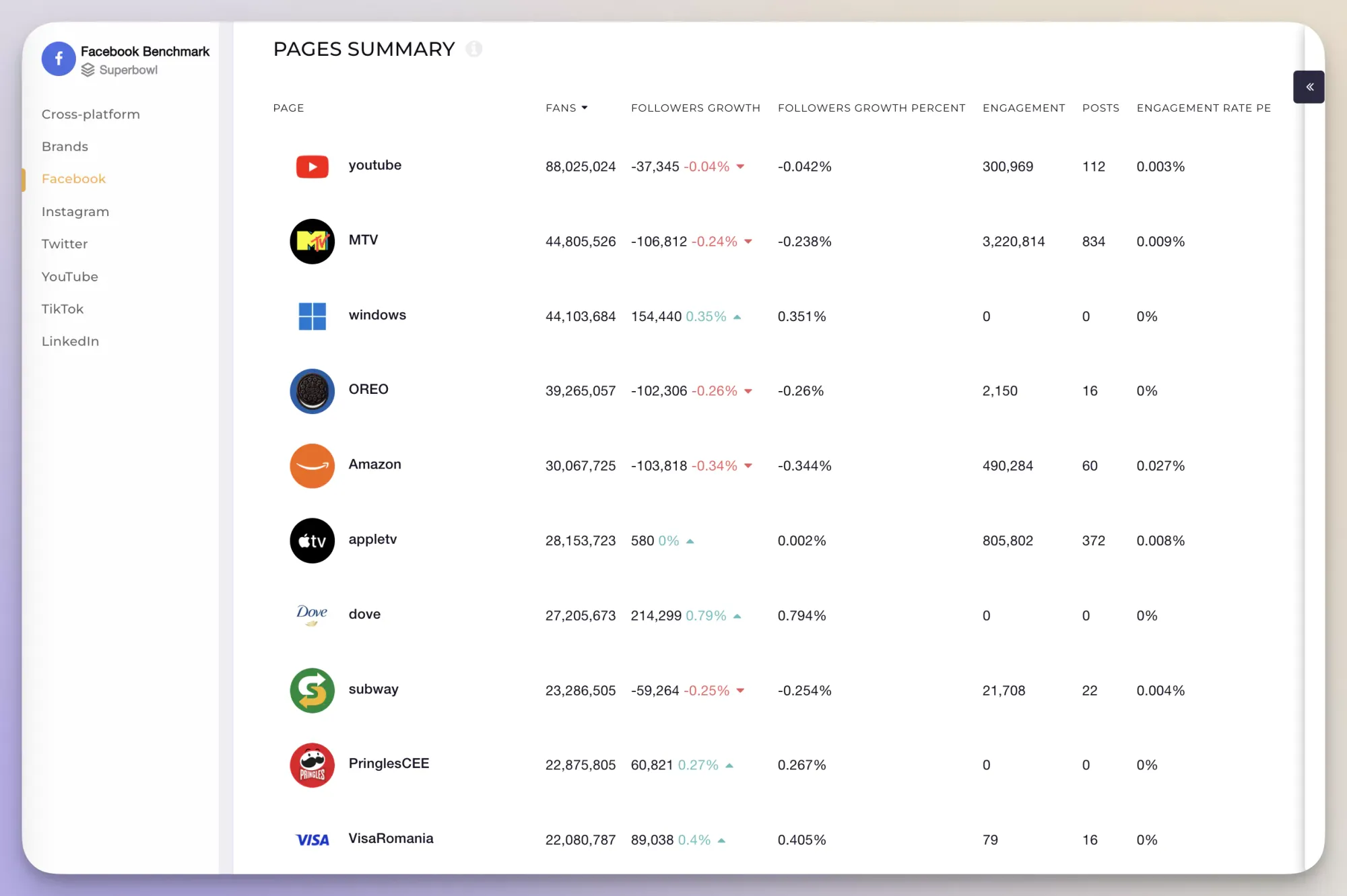
Channels to include:
Focus on the platforms most relevant to your audience, whether it's Facebook, Instagram, Twitter, or LinkedIn, or analyze across all channels.
With social media dashboard software like Socialinsider, you can monitor all channels and quickly switch to specific ones for deeper insights. Acces the benchmarks directly in the tool or easily integrate them in another social media dashboard app, such as Looker Studio.
Frequency
Check monthly to stay up to date with industry trends or whenever you are working on a campaign and need to refine it. Social media benchmarks help you choose proven tactics and optimize resources and results.
6. Social media conversion dashboard
See how your social media efforts drive results with a conversion dashboard. It helps you track the efficiency of your customer journey, revealing if your social strategy translates into sales.
Key metrics
- Conversion rate. Measures the percentage of users who take a desired action after interacting with your content.
- Click-Through Rate (CTR). Track how often people click on the links contained in your posts and optimize your call-to-action.
- Cost per conversion. Calculate the cost of getting a conversion through social media advertising.
- Lead generation. Count the number of potential customers generated through social media channels.
- Bounce rate. Measure the percentage of visitors who quickly navigate away from the website, indicating the relevance level of your content.
- Social media ROI. Evaluate the profitability of your social media activities by comparing the revenue generated to the cost of the campaigns.
Platforms to include:
- Facebook and Instagram — offer extensive user bases and advanced ad capabilities.
- Twitter — real-time engagement and promotional campaigns.
- LinkedIn — B2B marketing, focused on professional content and networking.
- Google Ads — track conversions from search engine marketing.
- Pinterest — key for brands in niches like fashion and home decor.
- YouTube — track conversions from video content engagements.
- TikTok — reach younger demographics with dynamic video content.
Frequency
Weekly checks of your conversions dashboard help you identify issues, optimize campaigns, and improve your social media ROI.
7. Network-specific dashboard
Access network-specific data to understand performance and fine-tune tactics on each channel.
Whether you use the analytics provided by each platform or centralize information through social media dashboard software, this type of dashboard allows you to perform a social media audit, to focus on the metrics that matter most on a particular social media network.
Key metrics
- Engagement. Track engagement metrics.
- Comments. Understand what type of posts drive more comments.
- Content type. Get the best performing posts.
- Likes. Understand content popularity.
- Shares. Measure share frequency to understand content reach and influence.
- Followers. Monitor growth in your follower base to understand brand attraction.
- Mentions. Count how often your brand is mentioned to assess engagement and brand visibility.
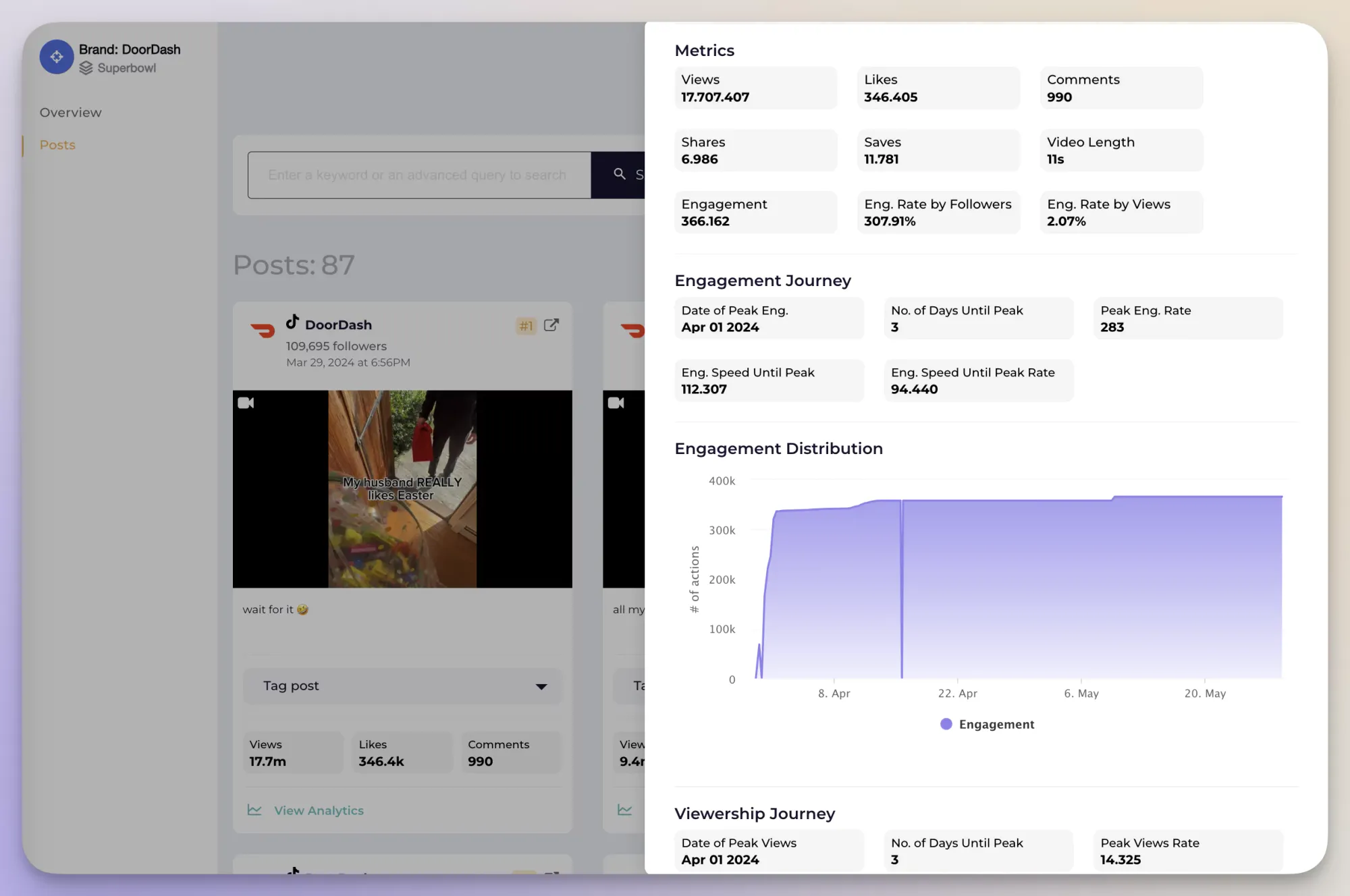
Channels to include:
Directly access the built-in analytics tools of platforms such as Facebook, Instagram, Twitter, or LinkedIn, depending on where your focus lies.
Socialinsider provides network-specific data, while also giving you access to a broader social media analytics dashboard and industry benchmarks.
Frequency
Weekly reviews are essential to be responsive and react rapidly to possible issues on different platforms.
8. Business intelligence dashboard
A business intelligence dashboard helps you assess your business's overall health, or it can help provide specific insights on product launch campaigns, special offerings, or marketing funnel performance.
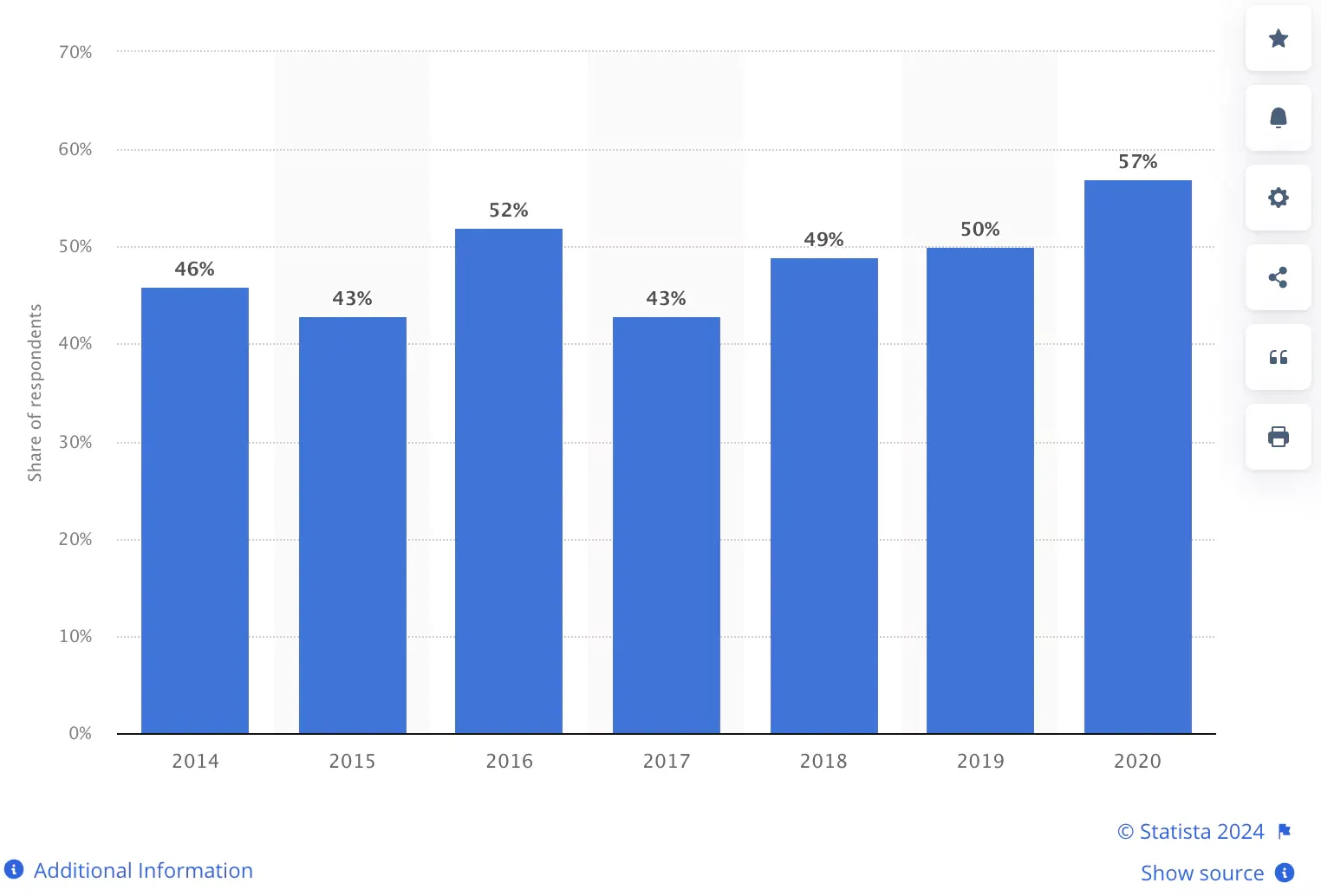
Overall, this is a good dashbord to include in stakeholder reports to empower them to make more informed decisions.
Key metrics
- Brand reach and impressions. Assess the extent to which your brand is recognized and considered in the market.
- Sentiment analysis. Evaluate the tone and emotions in social media mentions and customer feedback to understand public sentiment towards your brand.
- Engagement. Measure overall engagement to understand content efficiency or drill down into specific posts or campaigns to provide advanced insights.
- Social listening. Monitor mentions, hashtags, and discussions related to your brand across social media platforms to identify trends and customer concerns. Use an AI-powered dashboard to leverage the power of technology and automation.
Channels to include:
For a holistic view and comprehensive business insights, draw data from all channels and identify patterns and outliers.
Frequency
Regular monthly or quarterly checks are recommended to stay updated with fresh insights and update social media dashboards for C-level stakeholders.
9. Social media dashboard for executive teams
When you’re running a business, big or small, you need to sift through lots and lots of data. An executive dashboard will make this process much less complicated and easier.
These types of social media dashboards can filter the information that matters most to your company and allow easy monitoring by anyone interested.
Key metrics
- Brand reach.
- Brand impressions.
- Brand reputation. While leaders may not be that interested in engagement on specific posts, they do care about the overall reputation of the brand, as it directly affects sales and equity.
- Social media ROI. Monitors overall social media roi to demonstrate the effectiveness of marketing strategies.
- Marketing qualified leads from social media.
- Traffic from social media.
- Custom Key Performance Indicators. Evaluate business needs and goals and include the most relevant KPIs directly impacting financial health and business strategy.
Channels
Integrate data from various channels to provide a holistic view of the company's performance.
Frequency
Monthly or quarterly checks are typically enough for executives to have an up-to-date view of key metrics and use the information for business decisions. Ask for feedback to create a well-structured dashboard that’s truly useful to executives.
How to build your own social media dashboard
Social media dashboards are not as overwhelming as they sound. Sure, building one might seem daunting at first because there are so many moving parts to consider.
But with a few key elements in mind and powerful tools at your side, creating a social media dashboard tailored to your business needs can be a useful and enjoyable process.
#1. Set up social media goals
The first step is establishing your social media goals.
You have to determine what you want to achieve and figure out the relevant social media metrics to measure. Do you want to boost awareness of new products, generate more leads or build a community around your brand?
This is an important step because tracking every possible metric will be a lot of work and may create more confusion than clarity. Ideally, you'll build social media dashboards that only track metrics relevant to your goals.
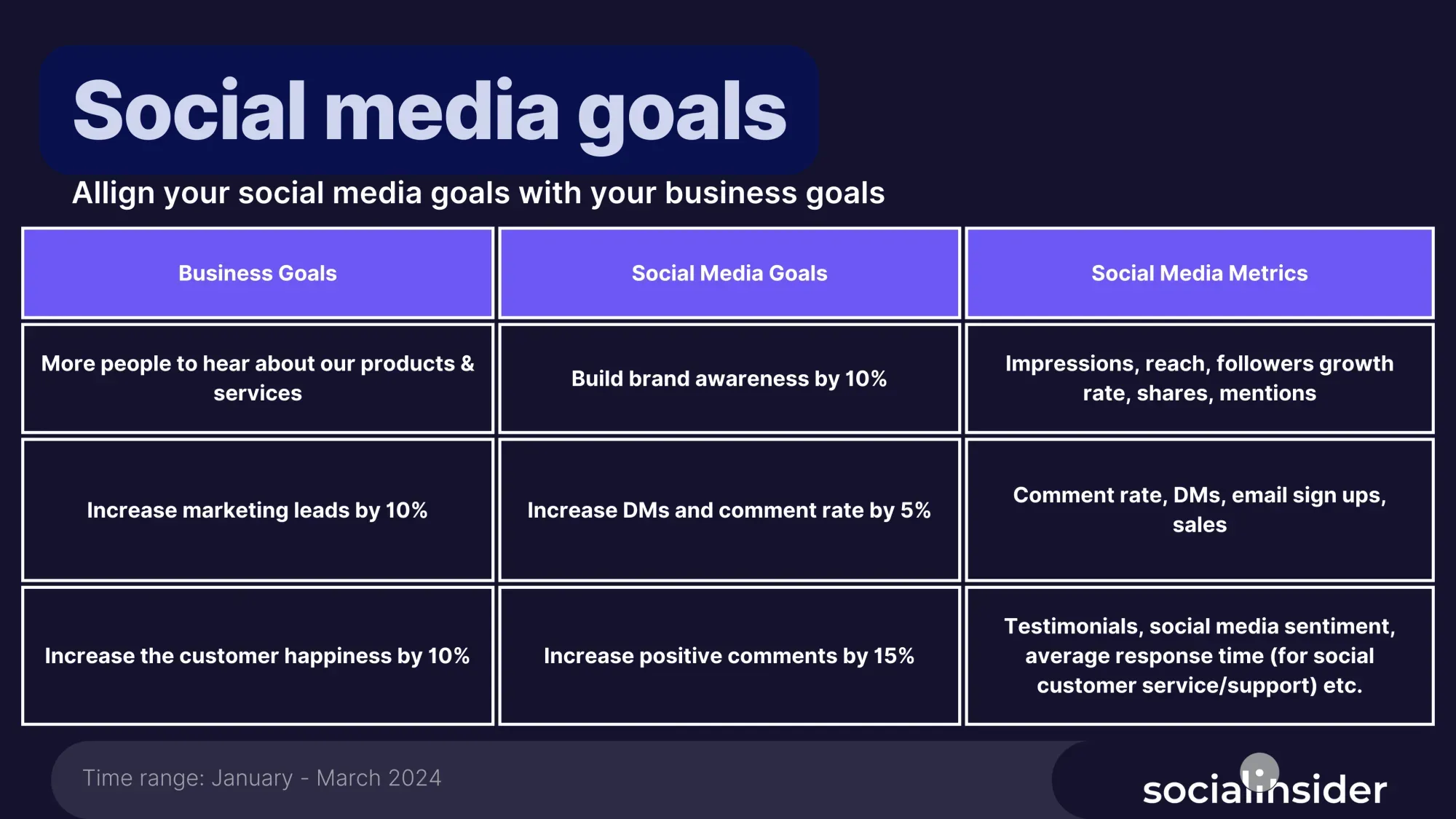
#2. Track social media metrics and KPIs
Social media dashboards are powerful because they turn raw data into useful insights you can act on.
By tracking relevant social media KPIs and metrics, you can understand how your social media goals advance in real time and optimize campaigns.
A good dashboard lets you monitor changes in likes, mentions, cost per lead, and other important metrics over time. This clear picture allows you to identify areas for improvement and be proactive rather than reactive.
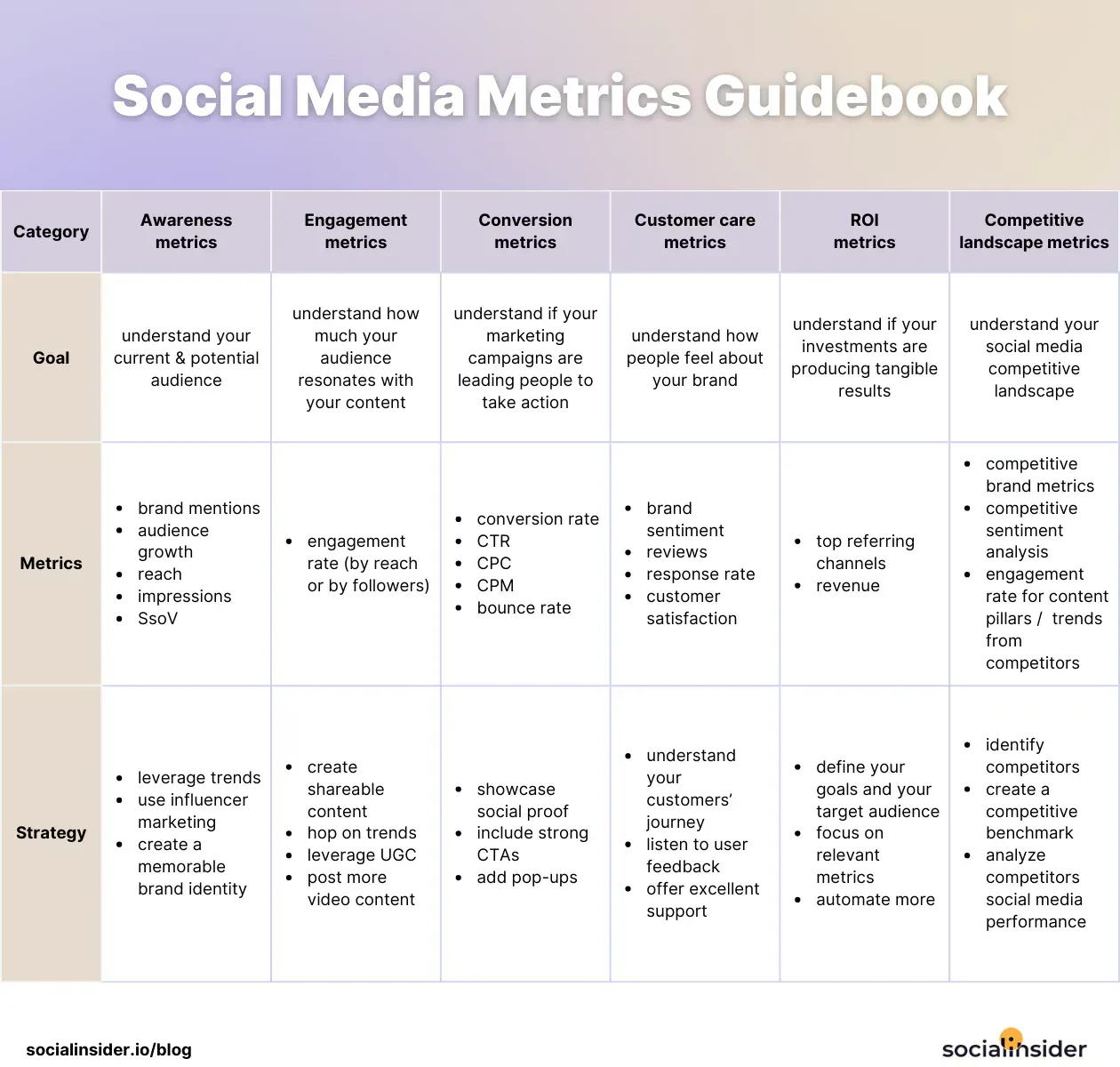
#3. Use a powerful social media analytics tool
Although it's possible to manually collect social media data from the various channels you're using, doing so involves a lot of work and leaves room for error.
Manual data collection also makes it nearly impossible to react quickly and adjust strategies to keep up with the trends and competition.
With a user-friendly dashboard, all that work is streamlined, faster, and easier to access.
A social media analytics tool like Socialinsider allows you to automatically access metrics in beautifully designed social media reporting dashboards.
→ 13 Best Analytics Tools For Instagram Performance Tracking
→ 18 Facebook Analytics Tools Every Marketer Should Know in 2024
→ 10 TikTok Analytics Tools for a Strong Social Media Strategy
Track changes in real-time, and rest assured that you don't miss opportunities for engagement and improvement.
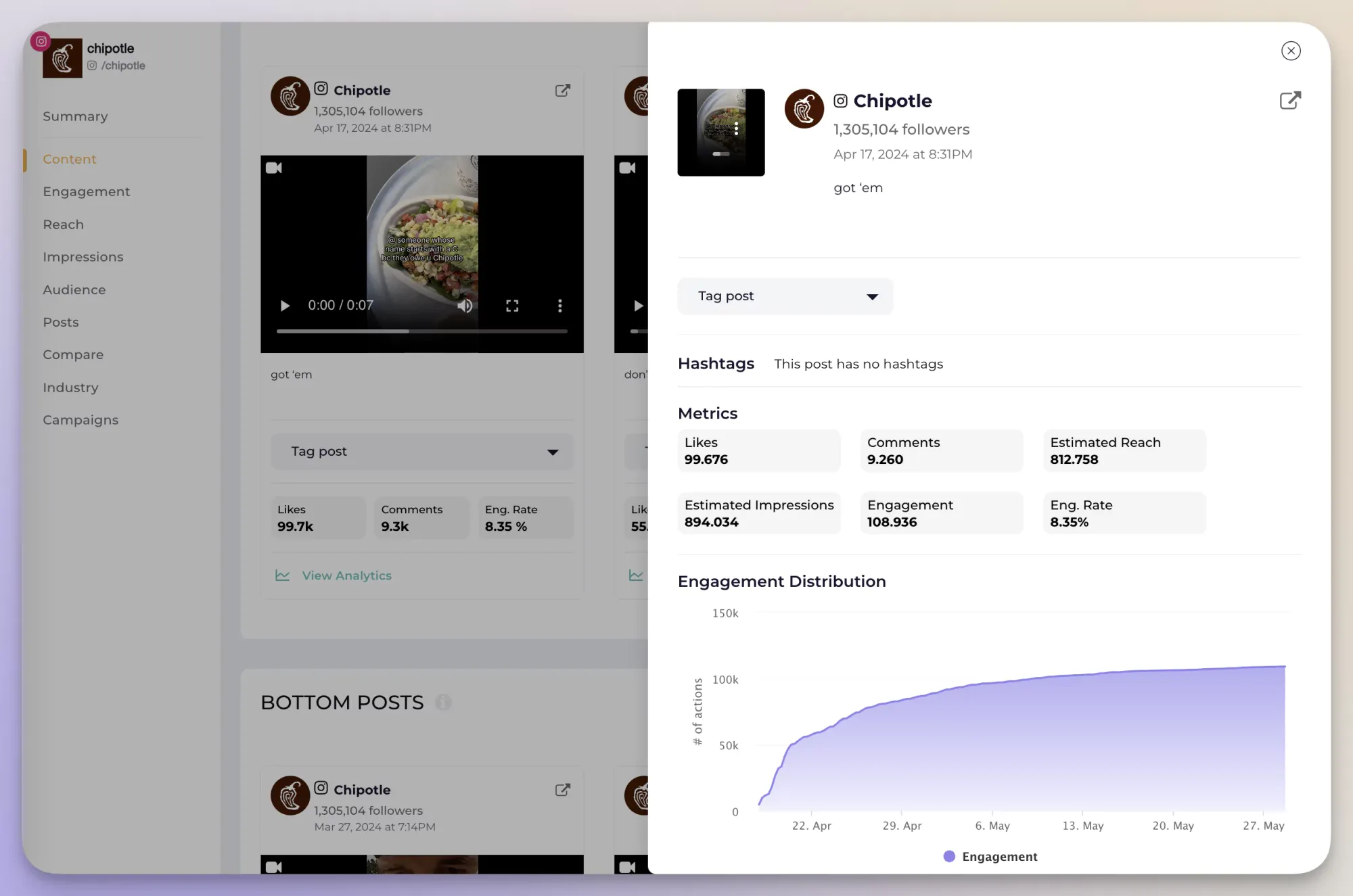
#4. Connect other data sources
Siloed data is a common problem in marketing. Many teams struggle to make sense of information that resides on various platforms and to put it together in a cohesive format.
Social media dashboards can connect the dots. By bringing in other data sources, you access a wealth of insights and gain a holistic view of your online presence.
Imagine integrating your social media marketing dashboard with analytics from Meta throught the social media APIs. This lets you see how your social media engagement performs across major social media channels.
Additionally, you can connect social listening tools to monitor campaign hashtags and brand mentions across platforms, revealing the impact of your social efforts on brand awareness and social sentiment analysis.
This data centralization in a social media management dashboard creates a comprehensive picture of your digital performance. You can identify trends, optimize campaigns, and drive results that align with your marketing goals.
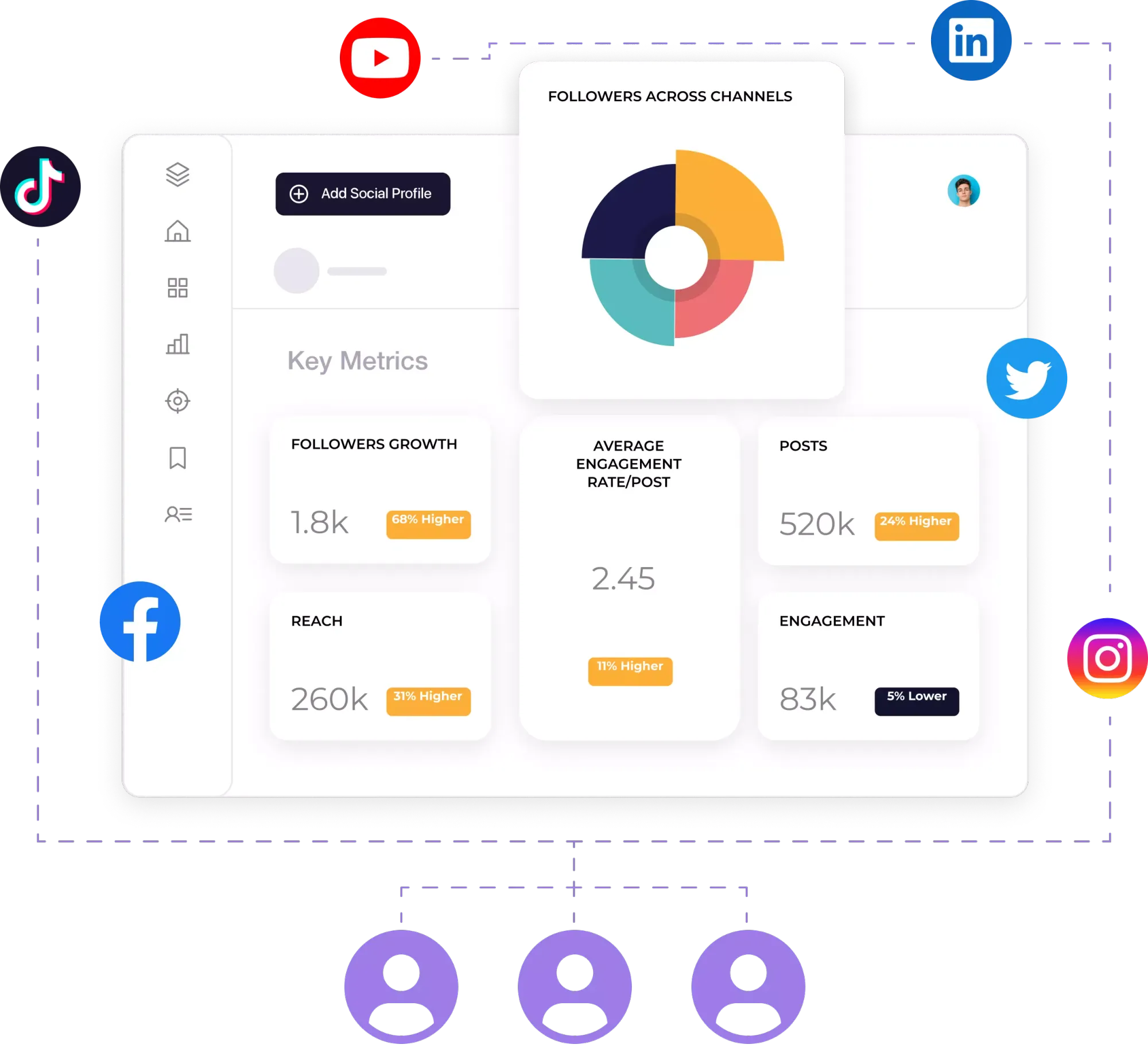
#5. Setup a Looker Studio dashboard
Looker Studio is a user-friendly data visualization and reporting tool that allows the creation of professional dashboards with pre-built templates and cloud-based accessibility.
The tool simplifies data connection, analysis, and presentation from various sources without the need for advanced technical skills.
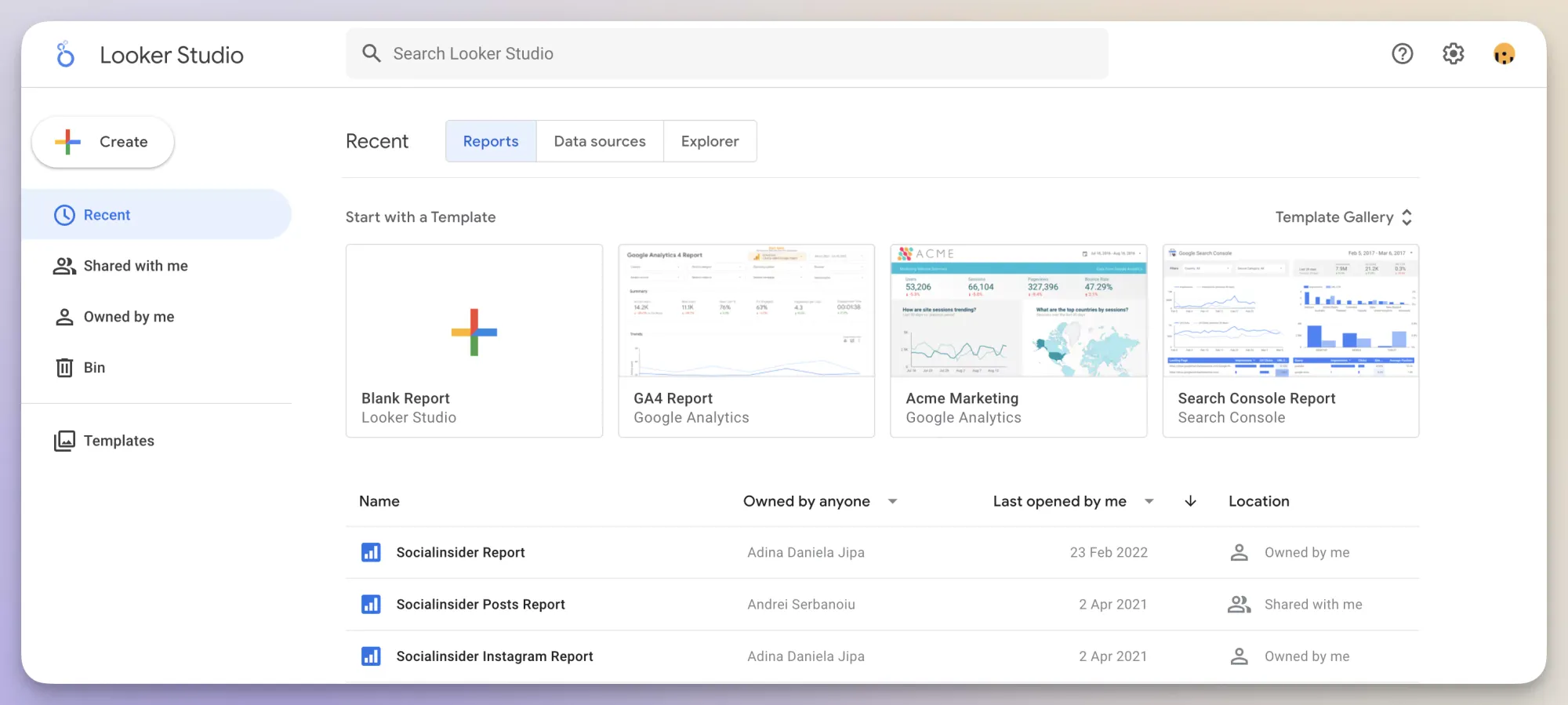
Connect Looker Studio to social media accounts or your social media analytics tool. This will allow real-time data extraction and monitoring metrics like engagement rates, reach, follower growth, and content performance.
Looker Studio offers extensive customization options, including setting date ranges, filtering data based on demographic or geographic details, and comparing performance across different periods or campaigns.
You can also set up automated insights to alert you when your data shows significant changes or anomalies.
The platform allows you to share your social media analytics dashboard with team members or stakeholders, ensuring transparency for everyone involved in marketing efforts.
Other tools you can use for creating social media dashboards:
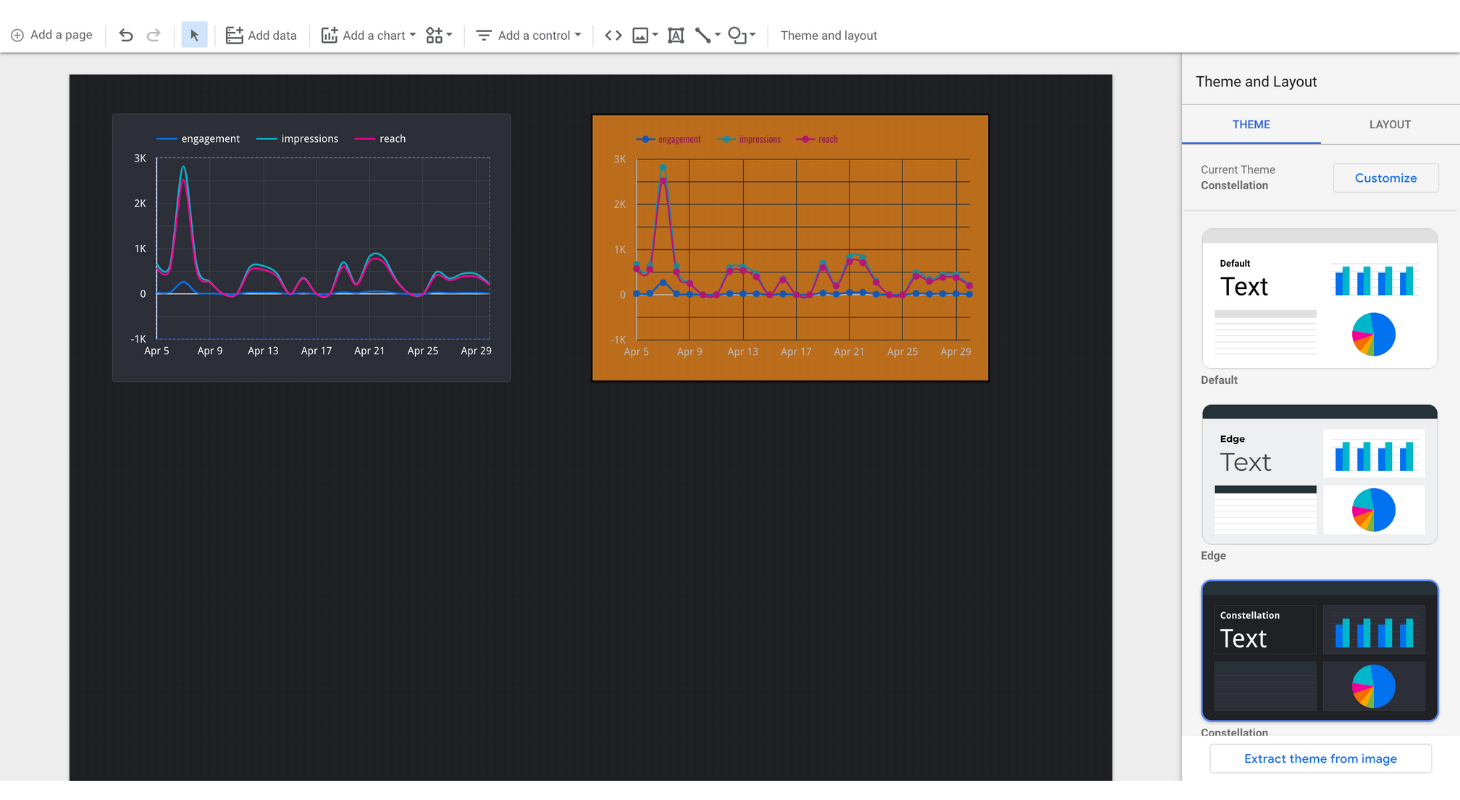
Final thoughts
There you have it — with so many social media dashboard examples and best practices at your disposal, you should be able to create reports that are relevant and valuable for your business.
Of course, there are many pieces to the puzzle to fit in, so don’t hesitate to get a helping hand from a specialized social media dashboard analytics tool. Socialinsider was created to make social media managers’ lives easier and simplify decision-making, and you can try it for free.
